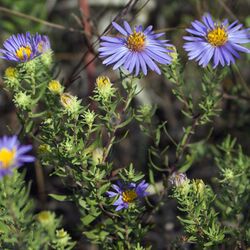Biology:Symphyotrichum oblongifolium
| Symphyotrichum oblongifolium | |
|---|---|

| |
| Scientific classification | |
| Kingdom: | Plantae |
| Clade: | Tracheophytes |
| Clade: | Angiosperms |
| Clade: | Eudicots |
| Clade: | Asterids |
| Order: | Asterales |
| Family: | Asteraceae |
| Tribe: | Astereae |
| Subtribe: | Symphyotrichinae |
| Genus: | Symphyotrichum |
| Subgenus: | Symphyotrichum subg. Virgulus |
| Section: | Symphyotrichum sect. Grandiflori |
| Species: | S. oblongifolium
|
| Binomial name | |
| Symphyotrichum oblongifolium | |

| |
| Native distribution[2] | |
| Synonyms[1] | |
|
Basionym
Alphabetical list
| |
Symphyotrichum oblongifolium (formerly Aster oblongifolius), commonly known as aromatic aster[3] or oblong-leaved aster,[2] is a species of flowering plant in the family Asteraceae and is native to parts of the eastern and central United States. It is an uncommon herbaceous perennial[4] that reaches heights of 10–80 centimeters (4–31 inches) and blooms August–November with many flower heads in various shades of purple.[2]
Description
Aromatic aster is a perennial, herbaceous flowering plant that reaches heights of 10–80 centimeters (4–31 inches) on one to ten or more stems growing from a sturdy caudex. It blooms August–November with many flower heads in various shades of purple.
Distribution and habitat
Aromatic aster is found in parts of Kansas ,[5] Ohio, northern Illinois, hilly parts of southern Illinois, and on the banks of the Mississippi River and Illinois River,[6] as well as other parts of the central United States. It is found in Missouri, along the Ohio River,[3] and from Pennsylvania to Nebraska to Minnesota to Virginia.[7]
Conservation
(As of July 2021), NatureServe listed Symphyotrichum oblongifolium as Secure (G5) worldwide; Critically Imperiled (S1) in Colorado and North Carolina; Imperiled (S2) in Wyoming; and, Vulnerable (S3) in Indiana and Ohio.[8]
Citations
References
- (in en) An Illustrated Flora of the Northern United States and Canada. 3. Dover Publications. 1970. p. 366. https://archive.org/details/anillustratedfl00browgoog. Retrieved 3 December 2009.
- Flora of North America Editorial Committee, ed. (2006), "Symphyotrichum oblongifolium" (in en), Flora of North America North of Mexico (FNA), 20, New York and Oxford, http://www.efloras.org/florataxon.aspx?flora_id=1&taxon_id=250067664, retrieved 10 September 2021
- Burns, J. (January 1983). "Aster Oblongifolius Nutt. Shale Barren Aster" (in en). Ohio Department of Natural Resources. http://www.dnr.state.oh.us/Portals/3/Abstracts/Abstract_pdf/A/ASTER_OBLONGIFOLIUS.pdf.
- Template:Cite Kansas Wildflowers
- Template:Cite Illinois Wildflowers
- "Symphyotrichum oblongifolium Aromatic Aster" (in en). Arlington, Virginia. 2 July 2021. https://explorer.natureserve.org/Taxon/ELEMENT_GLOBAL.2.139732/Symphyotrichum_oblongifolium.
- POWO (2019). "Symphyotrichum oblongifolium (Nutt.) G.L.Nesom" (in en). Royal Botanic Gardens, Kew. http://www.plantsoftheworldonline.org/taxon/981868-1.
- "Symphyotrichum oblongifolium" (in en). Natural Resources Conservation Service PLANTS Database. USDA. 2014. https://plants.usda.gov/core/profile?symbol=SYOB.
External links
- Petersen, Roger Tory; McKenny, Margaret (1998). A Field Guide to Wildflowers: Northeastern and North-central North America. Houghton Mifflin Harcourt. p. 358.
Wikidata ☰ {{{from}}} entry
 |









